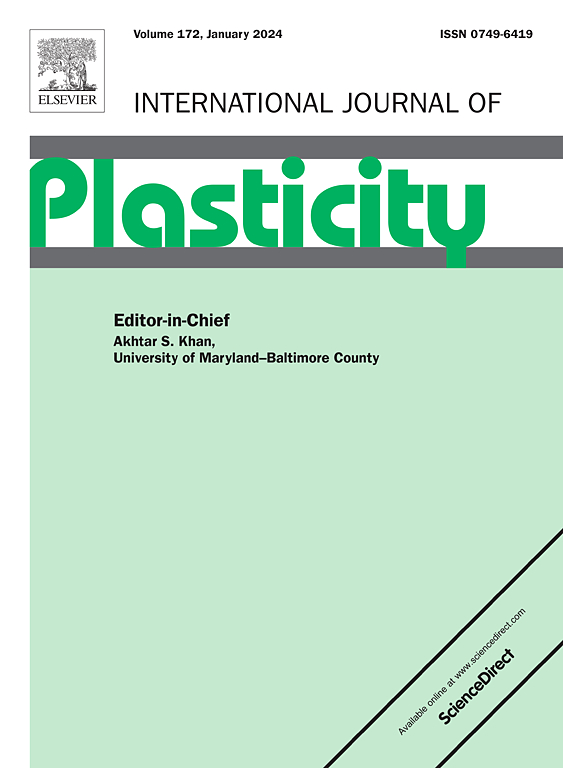在准静态应变速率下,动态碳扩散诱导高碳加铝奥氏体钢的持续应变硬化
IF 12.8
1区 材料科学
Q1 ENGINEERING, MECHANICAL
引用次数: 0
摘要
钢的应变硬化行为设计通常涉及控制变形机制的激活和变形过程中微观组织的演变。本研究提出了一种新的策略,通过高碳设计来钉住位错,利用动态应变时效(DSA)来促进持续硬化,从而在准静态应变率下提高抗拉强度和延展性,而不依赖于微观结构的调整。研究表明,在热激活状态下(应变率为10-3 ~ 10-1 s-1),较低的应变率更有利于合金获得较大的应变硬化能力。有趣的是,在较低应变速率下,严重变形的显微组织显示出较低的亚结构密度,但却表现出增强的流动应力。这一差异表明观察到的合金硬化变化偏离了常规的亚结构演变规律。透射电镜和电子背散射衍射分析表明,低应变率抑制了额外孪晶体系的形成,促进了以交叉滑移为主的细胞结构。位错动力学和碳扩散速率的理论计算证实了DSA在应变速率敏感性中占主导地位。在高温下的拉伸试验表明,极限拉伸强度和延展性都有显著改善。这一观察结果,结合循环时效-再加载试验,强调了DSA在富c合金硬化中的关键作用。通过展示动态间隙扩散对应变硬化和应变速率响应的实质性影响,本研究证实了DSA在环境温度下诱导了大量硬化。结果表明,在应变速率为10-3 s-1时,合金的应变硬化能力比在应变速率为10-1 s-1时提高了100 MPa以上,同时合金的抗不稳定性和伸长率也提高了近10%。尽管孪晶和位错密度有限,但该合金通过溶质-位错相互作用获得了优异的力学性能,超越了过度依赖子结构演变的传统硬化模型的预测。这项研究为设计未来在准静态应变率下具有优越强度和延展性的合金提供了一条有希望的途径,有可能克服传统的通过溶质-位错相互作用的强度-延性权衡。本文章由计算机程序翻译,如有差异,请以英文原文为准。


Dynamic carbon diffusion induced sustainable strain-hardening at quasi-static strain rates in high-C Al-added austenitic steels
The design of strain-hardening behavior in steel typically involves controlling the activation of deformation mechanisms and the evolution of microstructure during deformation. This research proposes a novel strategy to promote sustained hardening by leveraging dynamic strain aging (DSA) through a high-C design to pin dislocations, thus enhancing tensile strength and ductility at quasi-static strain rates, independent of microstructure tailoring. This study reveals that lower strain rates are more conducive to achieving greater strain-hardening capacity in the new alloys within the thermally-activated regime (strain rates of 10–3 to 10–1 s–1). Intriguingly, heavily deformed microstructures show reduced substructure density at lower strain rates, yet exhibit enhanced flow stress. This discrepancy indicates that the observed changes in the alloy’s hardening deviate from conventional substructure evolution law. Transmission electron microscopy and electron backscatter diffraction analyses show that low strain rates inhibit the formation of additional twin systems and promote a predominantly cellular structure dominated by cross-slip. Theoretical calculations of dislocation dynamics and carbon diffusion rates confirm that DSA dominates strain rate sensitivity. Tensile tests at elevated temperatures demonstrate notable improvements in both ultimate tensile strength and ductility. This observation, combined with cyclic aging-reloading tests, underscores the critical role of DSA in the hardening of C-enriched alloys. By demonstrating the substantial impact of dynamic interstitial diffusion on strain-hardening and strain rate response, this study confirms that DSA induces substantial hardening at ambient temperature. This results in the alloy at a strain rate of 10–3 s–1 exhibiting a strain-hardening capacity exceeding 100 MPa higher than that at 10–1 s–1, while also achieving improved resistance to instability and an elongation increase of nearly 10 %. Despite limited twinning and dislocation density, the alloy achieves superior mechanical properties through solute-dislocation interactions, surpassing predictions of conventional hardening models that over-rely on substructure evolution. This study offers a promising avenue for designing future alloys with superior strength and ductility at quasi-static strain rates, potentially overcoming the traditional strength-ductility trade-off via solute-dislocation interactions.
求助全文
通过发布文献求助,成功后即可免费获取论文全文。
去求助
来源期刊

International Journal of Plasticity
工程技术-材料科学:综合
CiteScore
15.30
自引率
26.50%
发文量
256
审稿时长
46 days
期刊介绍:
International Journal of Plasticity aims to present original research encompassing all facets of plastic deformation, damage, and fracture behavior in both isotropic and anisotropic solids. This includes exploring the thermodynamics of plasticity and fracture, continuum theory, and macroscopic as well as microscopic phenomena.
Topics of interest span the plastic behavior of single crystals and polycrystalline metals, ceramics, rocks, soils, composites, nanocrystalline and microelectronics materials, shape memory alloys, ferroelectric ceramics, thin films, and polymers. Additionally, the journal covers plasticity aspects of failure and fracture mechanics. Contributions involving significant experimental, numerical, or theoretical advancements that enhance the understanding of the plastic behavior of solids are particularly valued. Papers addressing the modeling of finite nonlinear elastic deformation, bearing similarities to the modeling of plastic deformation, are also welcomed.
 求助内容:
求助内容: 应助结果提醒方式:
应助结果提醒方式:


